Time, Space and Presence: Open House Junior at IMMA
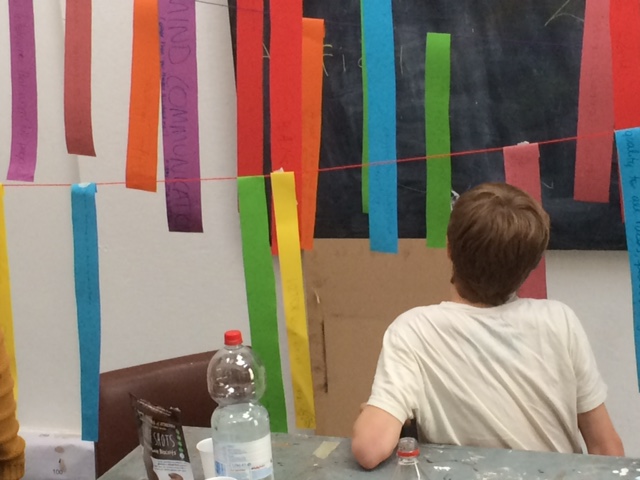
This October IMMA hosted an exciting workshop for teens, as part of Irish Architecture Foundation’s Open House Dublin.The session was an exploration of space and time by an impressive group of young people, and was facilitated by Paola Catizone and A. Legarreta (‘maken’) from the IMMA Visitor Engagement Team. As we look back at the year that was we wanted to capture some of our highlights, so have asked Paola and maken to share their memories of the event.
The overall theme for the workshop was Time, Space and Presence, which takes as its cue the current exhibition IMMA Collection: A Decade. This collection exhibition is framed by a defined period of time – the last decade – and includes many works that are time-based or time-related. Many of the works also underline the importance of ‘presence’.
In our workshop we engaged with several different spaces at IMMA: the grounds; the West Wing Gallery to view A Decade, and Studio 10 – one of the studio spaces on site. We focused on the contrast between linear time (where time is an absolute physical reality, and where the passage of time is independent of consciousness) versus ‘being in the now’, and on the effect of architectural space on human daily experience.
We started in the grounds of IMMA with maken, using a Time Machine…
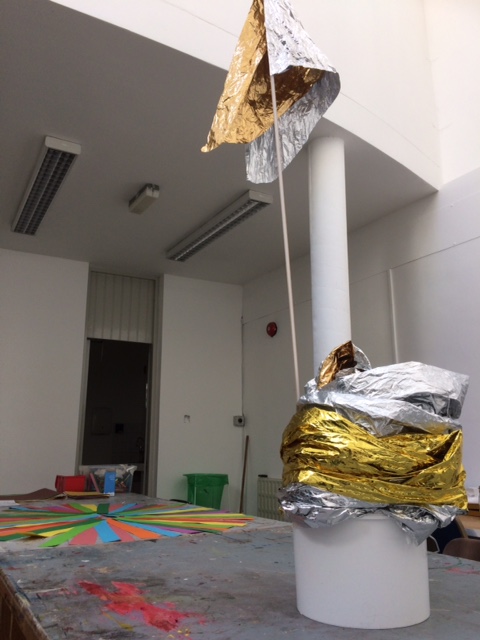
We built a Time Machine with the group. Yes, we did.
Participants assembled at the base camp/Studio 10 to meet their crewmates and be briefed on the space-time hopping planned for the day. The usual safety announcements were made, including the possibility that we would all be vaporized in the time machine, accidentally transported to Mars, etc, etc.
304 seconds later (4 seconds behind schedule, but we are at IMMA, not NASA), we left base camp. The Krono-nauts, aka Time-travellers, marched in formation to the designated launch site South of the RHK Clock Tower (yes, most appropriate). As we marched, we signaled our presence by our team flag – a pair of futuristic wings that flapped in the air as we walked. We carried with us our very own home-made Time Machine, which, conveniently, had been designed to fit into a bucket (see image above). The Machine consisted of an ‘electomagnetic’ gold-silver ‘aeronautical’ drapery, 16.2m long, threaded with our own imaginary experimental metal alloy, immanite™… and we were off!
After announcing the first destination, the Krono-nauts were asked to close their eyes. With a din of strange machine-sounds (closely resembling the ding-ding of a pantry-bell and the gong of… well… a meditation-Gong), we navigated through the space-time continuum, for what really and truly felt like 5 seconds. Without opening our eyes, like human-compasses, the crew were instructed to turn their bodies south-east to face the exact location. When they opened their eyes, the pilot described the building/ structure/ site they were beholding…
This space-time jump was repeated a number of times. Among other destinations we travelled to….
…the year 974, the outskirts of Dubh Linn in Hibernia. A hut Built by a young hermit called Maignenn, later known as ‘the place of Maignenn, or… ‘Kill-Mainham’.
…1679, Paris, France. ‘Les Invalides’ building. Officer Arthur Forbes falls in love with this military retirement home and persuades king Charles II to build a replica in Dublin.
…1880, Kandahar, Afġānistān. The site of an anti-colonial battle. A burial place will be erected in the IMMA gardens for a member of the British colonial troops at Kandahar. The warrior, who received a medal from Queen Victoria, was Volonel, an Arab horse.
…1940, Berlin, Deutschland. Detlev-Rohwedder building, the largest office building in Europe, headquarters of the Reich Air Ministry. A nameless secretary files a photograph of the RHK taken by the Luftwaffe. The file, called ‘Operation Green’, holds tactical information for a Nazi invasion of Ireland.
After several such space-time jumps, and safely returned to the launch-site, Krono-nauts were told that they had all now become Human Time Machines, with the ability to take other people back in time to all those places they had learned about, simply by repeating the stories they had heard.
We then moved to the West Wing to explore Old and New” tour, with Paola
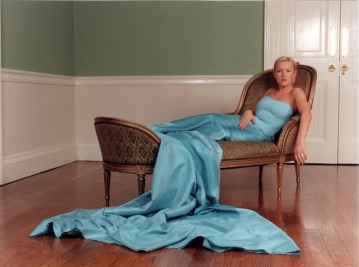
Within A Decade, we looked at works by Mark Dion, Kevin Atherton, Amanda Coogan, Corban Walker, Alexis Harding, Dennis Mc Nulty and Philippe Taaffe as each one of these works invites reflections on the passing of time, with materials, media and use of space carefully and deliberately chosen by the artists to create sharp contrasts between present and past. Each art work inhabits the surrounding space on its own terms, sparking up a dynamic between contemporary art and historical architecture. The walls of the RHK are soaked in history and yet they comfortably host artworks that, while in conversation with the past, are of the present and speak to it.
Atherton’s performative video installation is one of IMMA’s latest acquisitions supported by The Hennessy Art Fund for IMMA Collection. It consists of projections of two videos featuring present time Atherton in dialogue with his younger self, one filmed in 1978 and another in 2014. The older film has been re-edited to simulate this dialogue, and the arrangement of the projections within the room forces viewers to turn to look left and right, to follow the conversation, in a way that makes us participate in the performance.
Harding examines time from a different perspective. By using two painting mediums –oil and emulsion—with different drying times the artist can exhibit wet, dripping paintings which continue to form and change as you watch them, changing over time to dynamic effect.
McNulty’s multi-media installation, also supported through the Hennessy Art Fund, takes as its point of departure texts from Olaf Stapleton’s fictitious timeline for ‘Last and First Men‘, which he displays in a looped LCD. The timeline imaginatively extends from prehistory to a dystopian future threatened by a solar catastrophe. The windows in the room are partially covered by orange gel sheets while foil plaster boards reconfigure the shape of the walls and an acapella version of “The sun always shines on TV” by Norwegian 1980s band A-ha is the looped sound track. We find ourselves immersed within a sensory environment that hints at a future human existence lived in synthetic, manmade spaces surrounded by a threatening external world, no longer habitable.
In the studio
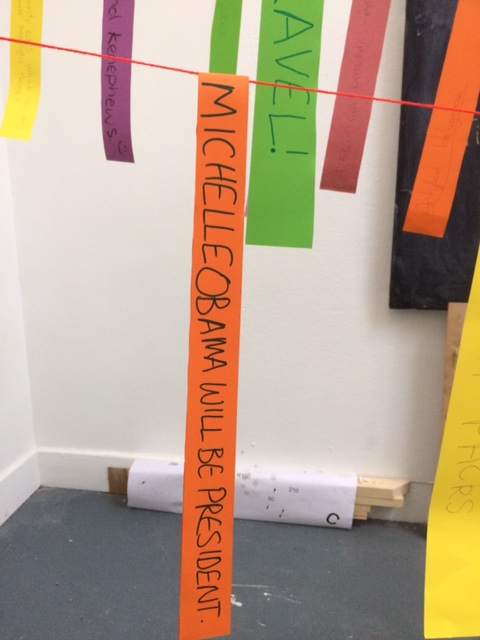
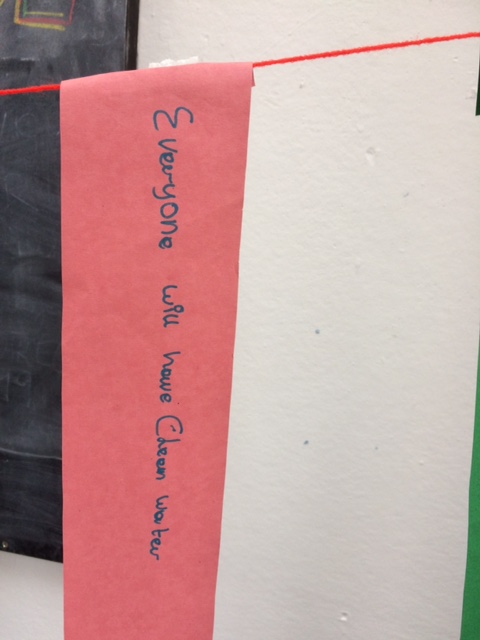
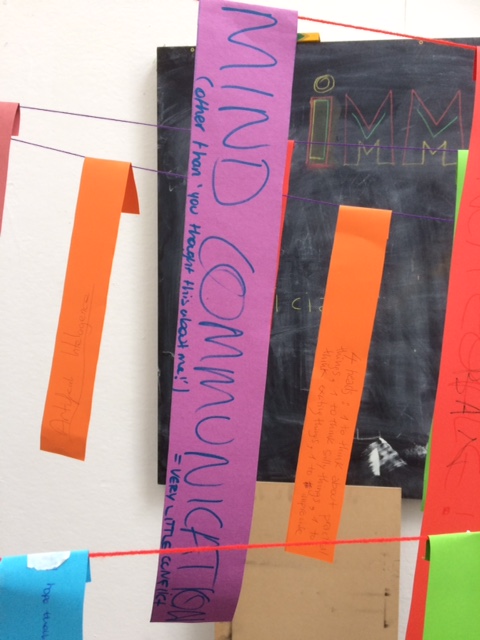
Having looked at the work in the galleries and explored the grounds the group decamped to the studio where they were invited to respond to the exhibition in ways that were physically active and sensorily rich – breaking away from a traditional reliance on the use of paints and crayons to make art.
The workshops started with an ice-breaker name-game, a visualization on architectural space, and a movement exercise by Augusto Boal. In another exploration we imagined the world at various stages in the next 1,000 years, a sci-fi fantasy as a response to Dennis McNulty’s installation, with the resulting texts jumbled up and read anonymously: “I don’t think there will be a planet Earth in the future”, one read, and “Aliens will live among us”, another. The group also created an installation built by writing their hopes for the future on coloured strips of paper, and attaching them to thread crisscrossing the Studio space: “Clean water for everyone” and “Infinite Knowledge” could be read. The process was simple but the result was visually and emotionally impactful. It was a privilege to witness this young group’s hopes and thoughts on the future. May all their hopes come true!

Categories
Further Reading
A Successful Summer of Teen Workshops
Over the summer, IMMA’s series of artist-led holiday workshops continued for teens aged 12 to 18. Janine Davidson led the first workshop in June, and John O'Connell led the second in July.
Free Art Workshops at IMMA. Easter Holidays
Next week the Easter holidays roll around once more and we have some great activities in store at The Irish Museum of Modern Art for children of all ages.
Mid-Term at IMMA : Halloween Workshops
Halloween is nearly here and IMMA has a host of workshops and activities for families and young people during the mid-term break.
Up Next
IMMA Shop: Christmas 2016
Thu Dec 1st, 2016